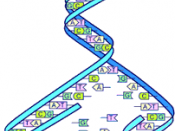Introduction to the Human Genome Project
The Human Genome Project began in 1986 as a way for scientists in the U.S. Department of Energy (DOE) to use newly developing DNA analytical technologies to fulfill a long-standing mandate from Congress to assess the health effects of radiation. For decades the DOE and its predecessors have developed international standards for the use of advanced medical diagnostic tools and treatments involving radiation and the protection of workers in the federal and civilian nuclear industry.
As the potential benefits of human genetics research became more apparent, Congress requested that the DOE and the U. S. National Institutes of Health develop a joint genome project. The U.S. Human Genome Project (HGP) began formally in 1990 with expanded goals to describe all human DNA by 2005. However, rapid scientific achievements moved the completion date foreward to 2003. International research teams, mainly those from the United Kingdom but also from France, Germany, and Japan joined U.S.
scientists and made major contributions to the HGP.
Today researchers worldwide are using HGP data and powerful analytical technologies to devise creative uses in an expanding range of fields. The claims and promises of these new capabilities are diverse and bold. But the new expertise and the data they generate also present complex ethical and policy issues that individuals and society, including the courts, have begun to confront.
Scientific Findings
Genome - A genome is a complete set of coded instructions for making and maintaining an organism. It is made up of the chemical DNA.
Chromosome - The complete human genome is packaged into 46 pieces of DNA called chromosomes.
DNA - Short for Deoxyribonucleic Acid, DNA is the chemical that stores coded information on how, when, and where an organism should make the many thousands of different proteins required for...


